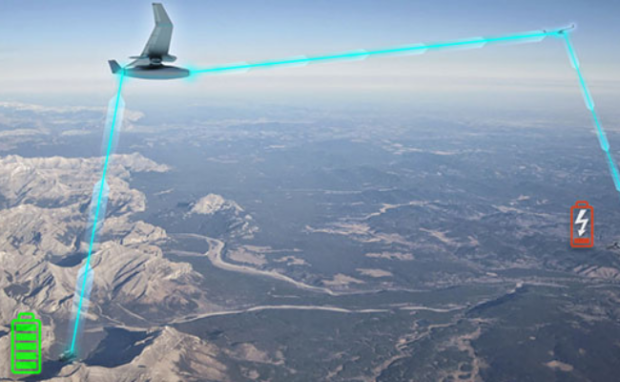DARPA and Raytheon making wireless energy web
The Defense Advanced Research Projects Agency (DARPA) awarded Raytheon a $10 million contract to create a “wireless internet for energy.” The Persistent Optical Wireless Energy Relay (POWER) will deliver energy to US military equipment. As a result, it could remove or reduce the military’s dependence on fossil fuel delivery and storage.
The most exciting possibility for this technology is mainstream adoption. After all, many of the devices and substances we enjoy today were once exclusive to the military. Soon, wireless energy webs could remove the need to recharge our devices by linking them to power outlets. Instead, the “cloud” could refill our batteries!
This article will discuss how such a “wireless internet for energy” would work. Later, I will share other recent energy innovations.
How would an energy web work?

New Atlas reports the POWER system will consist of unmanned aerial vehicles with laser-power receiving and transmitting capabilities. It starts by beaming energy from a ground power source to a POWER drone.
Then, the drone will relay the energy beam to its intended destination, such as a military vehicle or facility. If the target is far away, the POWER system will pass that energy to other drones closer to it.
As a result, the POWER system is an “energy web” that lets military tacticians route energy whenever and wherever it’s needed immediately. It will enable the US military’s land, sea, and sky-based units to operate indefinitely.
“This is the internet for energy, harnessing resilient, multipath networks to flow energy from abundant sources to energy-starved consumers,” said Col. Paul Calhoun, POWER program manager in DARPA’s Tactical Technology Office.
“The military faces particularly acute energy challenges, which are driving this innovation. We often must operate far from established energy infrastructure and rely on liquid fuels that require precarious supply lines.” Nowadays, militaries rely on supply lines to provide their vehicles and facilities with enough fuel.
However, those delivery systems could become a major weakness. For example, armed forces may target supply lines to stop an enemy from deploying tanks.
You may also like: We now know what’s inside the Moon’s core
Weather conditions like storms and snow could delay deliveries, too. In contrast, an energy web could mitigate those risks. However, New Atlas warns it has a few drawbacks.
Turning electricity into laser beams consumes 20% of the energy sent. Then, energy consumption increases to 50% when turning that light into electricity.
Nevertheless, DARPA is optimistic about this technology for military and civilian purposes. “It will dramatically compress transport timelines and resiliently provide distributed energy to consumers in air, on land, on the sea, undersea, and in space,” said Calhoun.
Other recent energy technologies
Their device "is the size of a thumbnail, one-fifth the width of a human hair, and capable of generating roughly one microwatt …in principle, we can stack multiple layers in vertical space to increase the power.”https://t.co/BAxIjQWqRw
— Maurice J. White (@WhiteMaurice) July 3, 2023
University of Massachusetts researchers created another “wireless” source of renewable energy. Professor Jun Yao said he and his team stumbled upon the technology when they were making a “simple sensor for humidity in the air.”
They made it with an array of microscopic tubes or nanowires. Each was less than one-thousandth the diameter of a human hair, wide enough for airborne water molecules to pass through.
“But for whatever reason, the student who was working on that forgot to plug in the power,” the professor added. The UMass Amherst team felt surprised when they saw water molecules generating electricity.
You may also like: Israel uses AI to facilitate military operations
They bumped inside the tube, producing a small charge. Moreover, both ends of the tube gained positive and negative charges as the molecules bumped further. “So it’s really like a battery,” says Yao. “The beauty is that the air is everywhere…. in principle, we can stack multiple layers in vertical space to increase the power.”
Also, a team of Scottish engineers created a new tidal turbine blade that could make energy from tidal waves more efficient. It is a project from the FastBlade company as part of the European Tidal Stream Industry Energizer Project or TIGER. Dr. Eddie McCarthy, FastBlade’s leader, said in a statement:
“We have found a faster, cheaper route to manufacture than the usual tidal blade fabrication process, based on an altered design – we hope the combination of improved design and optimized manufacturing process will contribute to reducing the levelized cost of energy (LCOE) of tidal stream energy, with the long term goal of matching LCOE of offshore wind.”
Conclusion
Raytheon and DARPA are creating a wireless energy web for the US military. The project will beam energy to an unmanned drone system to relay it to military installations.
As a result, tacticians could provide energy to critical areas whenever and wherever. Moreover, Raytheon said it would likely have civilian applications.
Soon, we might remove the need to recharge our devices by linking them to power outlets. Learn more about the latest digital tips and trends at Inquirer Tech.